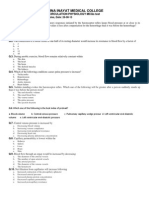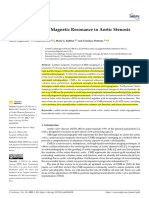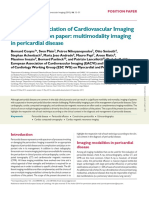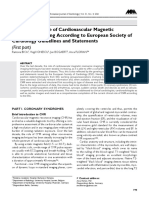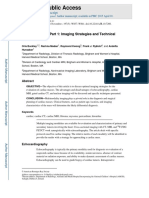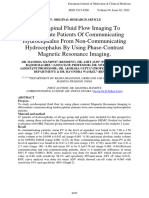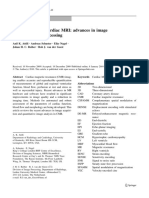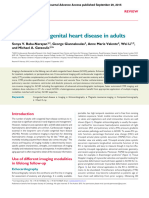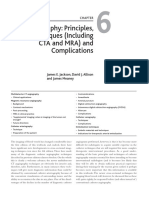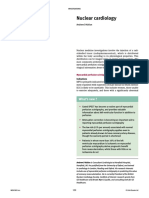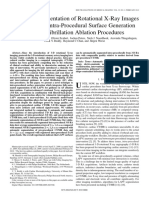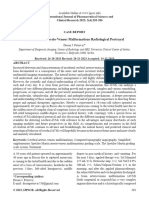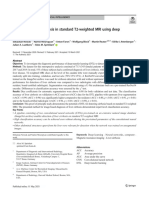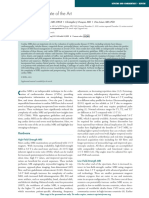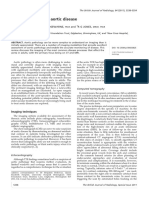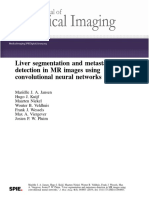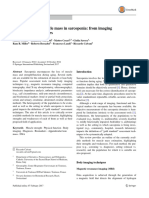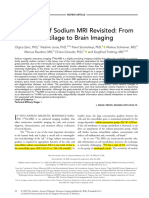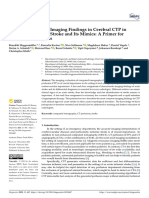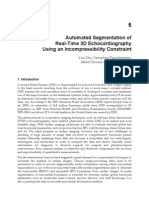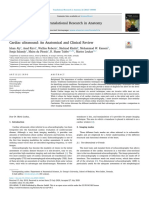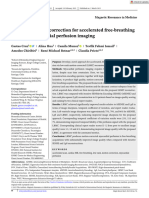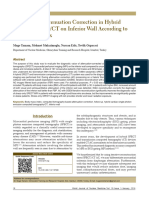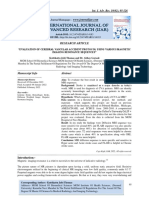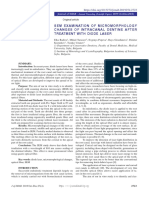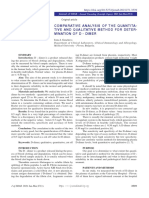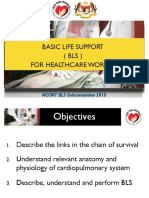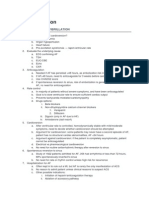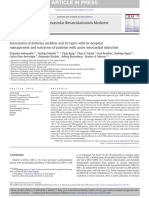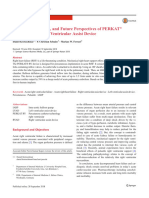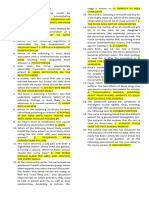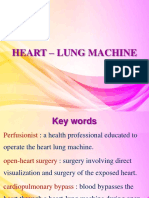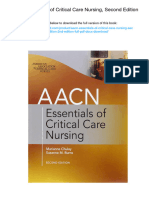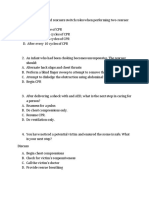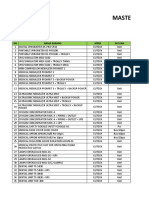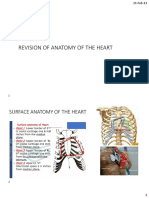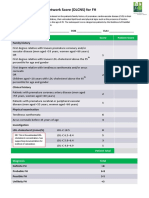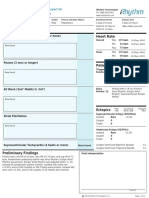0 ratings0% found this document useful (0 votes)
27 viewsApplications of Routine Cardiac Mri Pulse Sequences - A Contemporary Review
Applications of Routine Cardiac Mri Pulse Sequences - A Contemporary Review
Uploaded by
Dimitar KosturkovThis document summarizes the applications of routine cardiac MRI pulse sequences. It discusses how cardiac MRI utilizes different pulse sequences to provide morphological, functional, quantitative, and contrast-based cardiac imaging in a non-invasive manner without ionizing radiation. Specific pulse sequences discussed include fast spin echo, gradient recalled echo, steady-state free precession, and phase contrast imaging. The summary provides morphological and functional cardiac MRI sequences are used to characterize cardiac anatomy, function, mass, and flow. While powerful, cardiac MRI remains time-consuming and requires specialized and expensive equipment.
Copyright:
© All Rights Reserved
Available Formats
Download as PDF, TXT or read online from Scribd
Applications of Routine Cardiac Mri Pulse Sequences - A Contemporary Review
Applications of Routine Cardiac Mri Pulse Sequences - A Contemporary Review
Uploaded by
Dimitar Kosturkov0 ratings0% found this document useful (0 votes)
27 views5 pagesThis document summarizes the applications of routine cardiac MRI pulse sequences. It discusses how cardiac MRI utilizes different pulse sequences to provide morphological, functional, quantitative, and contrast-based cardiac imaging in a non-invasive manner without ionizing radiation. Specific pulse sequences discussed include fast spin echo, gradient recalled echo, steady-state free precession, and phase contrast imaging. The summary provides morphological and functional cardiac MRI sequences are used to characterize cardiac anatomy, function, mass, and flow. While powerful, cardiac MRI remains time-consuming and requires specialized and expensive equipment.
Original Description:
Original Title
APPLICATIONS OF ROUTINE CARDIAC MRI PULSE SEQUENCES – A CONTEMPORARY REVIEW
Copyright
© © All Rights Reserved
Available Formats
PDF, TXT or read online from Scribd
Share this document
Did you find this document useful?
Is this content inappropriate?
This document summarizes the applications of routine cardiac MRI pulse sequences. It discusses how cardiac MRI utilizes different pulse sequences to provide morphological, functional, quantitative, and contrast-based cardiac imaging in a non-invasive manner without ionizing radiation. Specific pulse sequences discussed include fast spin echo, gradient recalled echo, steady-state free precession, and phase contrast imaging. The summary provides morphological and functional cardiac MRI sequences are used to characterize cardiac anatomy, function, mass, and flow. While powerful, cardiac MRI remains time-consuming and requires specialized and expensive equipment.
Copyright:
© All Rights Reserved
Available Formats
Download as PDF, TXT or read online from Scribd
Download as pdf or txt
0 ratings0% found this document useful (0 votes)
27 views5 pagesApplications of Routine Cardiac Mri Pulse Sequences - A Contemporary Review
Applications of Routine Cardiac Mri Pulse Sequences - A Contemporary Review
Uploaded by
Dimitar KosturkovThis document summarizes the applications of routine cardiac MRI pulse sequences. It discusses how cardiac MRI utilizes different pulse sequences to provide morphological, functional, quantitative, and contrast-based cardiac imaging in a non-invasive manner without ionizing radiation. Specific pulse sequences discussed include fast spin echo, gradient recalled echo, steady-state free precession, and phase contrast imaging. The summary provides morphological and functional cardiac MRI sequences are used to characterize cardiac anatomy, function, mass, and flow. While powerful, cardiac MRI remains time-consuming and requires specialized and expensive equipment.
Copyright:
© All Rights Reserved
Available Formats
Download as PDF, TXT or read online from Scribd
Download as pdf or txt
You are on page 1of 5
https://doi.org/10.5272/jimab.2019254.
2718
Journal of IMAB
ISSN: 1312-773X
https://www.journal-imab-bg.org
Review article
APPLICATIONS OF ROUTINE CARDIAC MRI
PULSE SEQUENCES – A CONTEMPORARY
REVIEW
Georgi Valchev1,2, Ralitsa Popova 3, Samar El Shemeri 1,2, Yana Bocheva 4,5,
Nataliya Usheva6, Sonya Galcheva7,8, Violeta Iotova7,8, Yoto Yotov9,10
1) Clinic of Diagnostic Imaging, UMHAT Sveta Marina, Varna, Bulgaria
2) Department of Radiology, Medical University,Varna, Bulgaria
3) Department of Diagnostic Imaging, UMHAT Heart and Brain Center of
Excellence, Pleven, Bulgaria
4) Department of Clinical Laboratory, UMHAT Sveta Marina, Varna, Bulgaria
5) Department of General Medicine and Clinical Laboratory, Medical
University, Varna, Bulgaria
6) Department of Social Medicine and Organization of Healthcare, Medical
University, Varna, Bulgaria
7) First Paediatric Clinic with Intensive Care Department, UMHAT Sveta
Marina, Varna, Bulgaria
8) Department of Paediatrics, Medical University, Varna, Bulgaria
9) Second Clinic of Cardiology, UMHAT Sveta Marina, Varna, Bulgaria
10) First Department of Internal Medicine, Medical University, Varna, Bulgaria.
ABSTRACT: bringing new insights into pathology. Magnetic resonance
Cardiac magnetic resonance imaging is a relatively tomography (MRT) has now established itself as a stand-
novel method, which has recently vastly expanded its ap- ard of care in diagnosing cardiac tumors and infiltrative
plications and usefulness. It is a non-ionizing method, disease, exceeding the traditional gold standard of tran-
with very few contraindications, allowing for characteri- sthoracic ultrasonography (US) in terms of morphologi-
zation of the full spectrum of cardiac diseases. This is cal capacity and achieving levels of accuracy in func-
done by means of performing a multitude of specially-tai- tional imaging similar to those of real-time US. Cardiac
lored pulse sequences, each of which images different as- magnetic resonance (CMR) is also capable of evaluating
pects of morphology and pathology. When putting to- cardiac viability via perfusion techniques, making it a
gether all the data, acquired from the separate sequences, well-rounded diagnostic modality, albeit requiring expen-
a skilled radiologist can provide a comprehensive and in- sive equipment and highly experienced personnel. Unfor-
sightful interpretation to great clinical benefit. There are tunately, despite its great advances in imaging technol-
morphological, functional, quantitative, and contrast- ogy, cardiac MRI continues to be a time-consuming ex-
based imaging sequences, but not all of them are per- amination, demanding periods between 40 and 60 min-
formed on every patient – due to time constraints every utes for the acquisition of a comprehensive set of image
imaging protocol is individually calibrated to suit the sequences [2].
corresponding clinical query. Some advantages of CMR over Röntgen-ray-based
computed tomography (CT) include a strong native con-
Keywords: Magnetic Resonance Tomography, Car- trast between the varying soft tissues, the ability to de-
diac Imaging, Electromagnetic Pulse Sequences, Func- crease the field of view with retaining the same matrix
tional Imaging, Medical Imaging, Diagnostic Imaging, size (and thereby improve resolution), the ability to at-
tain data from any plane (unlike axial-only CT). Most im-
BACKGROUND: portantly, CMR is completely devoid of ionising radia-
Magnetic resonance imaging (MRI) is a relatively tion, making it superior to CT and nuclear medicine ex-
young imaging modality (the first MRI images of a hu- aminations in terms of patient dose. Cardiac MRI also pro-
man being were acquired in 1977 [1]). At the same time, vides superior spatial and temporal resolution when com-
MRI is one of the most rapidly and expansively develop- pared with nuclear medicine modalities, and, unlike ul-
ing imaging techniques. It has experienced further ad- trasonography, does not observe the limitations of acous-
vancements in recent years, with many new imaging se- tic windows [2].
quences having been introduced in a short time – each Cardiac MRT is not devoid of drawbacks, however.
2718 https://www.journal-imab-bg.org J of IMAB. 2019 Oct-Dec;25(4)
There is a necessity for sedation in children and claustro- to perform, and additionally – rather expensive [2].
phobic patients. Additionally, metallic implants with Each individual sequence consists of a mandatory
ferromagnetic effects as well as pacemakers are consid- imaging engine and non-mandatory image modifiers. Ex-
ered contraindications. amples of current imaging engines are Fast (or Turbo) Spin
Cardiac MRT is a noninvasive tomographic ima- Echo (FSE/TSE), Gradient-Recalled Echo (GRE) and its
ging method that can yield important morphological and successor balanced Steady-State Free Precession (SSFP),
functional data with a high image resolution. It has the Echo-Planar Imaging (EPI), while examples of modifiers
added advantage of imaging surrounding structures when are Inversion Recovery (IR), Fat Saturation (Fat Sat, sup-
anatomical sequences are employed, as well as the possi- pressing signal from fat by means of chemical shift), and
bility of adding intravenous contrast (Gadolinium chela- Phase-Contrast Imaging [3].
tes) and characterizing its passage. Measurements per- Morphologic sequences
formed on still images or cine series allow for accurate Morphologic sequences yield anatomic still images
calculation of chamber volume, mass, and size. The of the heart and great vessels as a mandatory part of any
imaging process is electrocardiographically (ECG) syn- clinical CMR investigation. They provide the most value
chronized – either ECG-gated (creates cine series of the when analyzing complex congenital anomalies and esti-
whole cardiac cycle) or ECG-triggered (static image ac- mating the span of cardiac masses. Most commonly at least
quisition in a specific part of the cardiac cycle – usually one of the anatomical series will be done in the standard
diastole). Cine series are small movies of a single slice, thoracic axial plane, however, quite often additional ob-
acquired from several consecutive and averaged out full lique planes, specific to the heart, are imaged as well –
cardiac cycles that enable for characterization of horizontal and vertical long axis views, two- and four-
contractility and calculation of left ventricular ejection chamber views, short axis view, views of the valves, out-
fraction [2]. Finally, respiratory synchronization needs to flow tracts, and great vessels [4-6].
be applied to adequately account for non-cardiogenic CMR sequences can be separated into two catego-
motion artefacts. This is usually done with short (18-25 ries, based on their myocardium-blood pool native con-
second) breath-hold commands in T1-weighted images or trast – dark (black) blood and bright (white) blood se-
with respiratory gating in T2-weighted images. The rea- quences. It is often desirable to use both of them for easier
son for this is that in T1, there are short time gaps in be- comparison. Dark blood sequences are aimed at optimal
tween imaging cycles, allowing for short breath-holds. representation of morphology as they provide a very clear
Conversely, with respiratory gating, no breath-hold com- distinction between the vessel wall and blood. They are
mands are given, instead, the patient’s diaphragmatic usually performed at multiple slice locations during di-
movements are automatically monitored, because, in T2- astole to produce a stack of 4-5mm thick slices. This par-
weighted images, the long gaps between cycles make tial coverage only of relevant anatomy is optimal in the
breath-hold techniques inapplicable [2]. view of time constraints. Dark blood images utilize a se-
Potential indications for CMR include cardiac ries of Inversion Recovery prepulses to null unwanted sig-
masses, quantifying myocardial ischemia or infarction (vi- nal – respectively a double IR prepulse to null blood sig-
ability), cardiomyopathies, valvular disease, coronary ar- nal, or a triple IR prepulse to null blood and fat. Exam-
tery disease (perfusion), pericardial disease, and complex ples of the imaging engines used are TSE, and its faster
congenital anomalies. [2, 3] variant Half-Fourier Acquired Single-shot Turbo spin Echo
(HASTE). Additionally, the Short-Tau Inversion Recovery
REVIEW RESULTS: (STIR) modifier can be of great use for identifying high-
There is a myriad of different pulse sequences. signal myocardium at risk in the setting of acute myocar-
These are unique combinations of field gradients and RF dial infarction. T2 STIR can also be used to search for
pulses, performed at different intervals that create differ- edema associated with acute infarction [3-7].
ently weighted images (T1-weighted, T2-weighted, diffu- Cine functional sequences
sion-weighted, etc.). Each such image provides different Bright blood sequences are built upon the SSFP and
information about the same anatomical area. For exam- EPI gradient engines and are an integral part of CMR ex-
ple, water appears very bright (high signal or hyper- aminations. They display high-intensity signal from fast-
intense) on T2-weighted sequences, and dark on T1- flowing blood (with an excellent distinction between
weighted sequences; fat appears bright on both T1 and blood and myocardium – figure 1) and are excellent at
T2. Both T1 and T2 series can additionally be performed evaluating cardiac function. These sequences continu-
with suppression of the signal from fat. Only when tak- ously image a single slice across several whole cardiac
ing all pertinent imaging sequences into consideration, cycles, creating a short averaged-out movie (cine) of the
one can acquire a comprehensive understanding of a heart in motion. The cine contains 20-30 frames, acquired
pathological finding. Additionally, as computing power with 30-50 msec temporal resolution – a set of 4 example
increases and the intrinsic engineering complexities of frames is shown in figure 2. Typically, a stack of multiple
magnets stack up, newer sequences emerge at an almost closely spaced short-axis slices (6-8 mm thick, with 1-2
alarming rate. It is this vast array of different types of im- mm gaps in between) is each turned into individual cine
ages that a radiologist must be familiar with that makes series to achieve adequate coverage. Thus they facilitate
MRT exceptionally difficult to interpret, time-consuming accurate assessment of the systolic and diastolic motion
J of IMAB. 2019 Oct-Dec;25(4) https://www.journal-imab-bg.org 2719
of the ventricular walls, both quantitative and qualitative. essarily easily reproducible with US. Phase Contrast meas-
Also, measurements can be made of left ventricular end ures the phase shift from blood protons moving through
diastolic and end systolic volumes, ejection fraction and the magnetic field (without the need for intravenous con-
myocardial mass can be estimated. Some sources recom- trast material), which is proportional to their speed, al-
mend cine SSFP as an alternative to echocardiography lowing for estimation of said speed and its direction. A
(cardiac US) [3]. cine series encompassing several phases of the cardiac cy-
cle is created. Velocity is encoded in a way reminiscent
Fig. 1. A single axial slice from a bright blood se- of colour Doppler in ultrasound. The imaging plane is
quence, clearly demonstrating left ventricular hypertro- usually perpendicular to a vessel, chamber, or valve of in-
phy. terest, with antegrade flow coded in light grey to white,
and retrograde flow coded in dark grey to black, while
stationary tissues appear intermediate grey. Time-veloc-
ity and time-flow curves can be generated. VENC is valu-
able for evaluating shunts and shunt fractions, determin-
ing pressure gradients across stenotic valves, and deter-
mining regurgitated flow [5, 6].
Quantitative MRI
In the last five years CMR mapping techniques
have been introduced, enabling the objective numerical
measurement of signal strength in every pixel of either
T1-, T2-, or T2*-weighted mapped images (which is im-
possible to do in images acquired via a different sequence).
This technique is mostly used for analyzing diffuse myo-
cardial changes. T1 mapping, for example, is very precise
in detecting infiltrative disease – myocarditis, amyloido-
sis, sarcoidosis, and cardiomyopathies. It is usually per-
formed in two phases – pre- and post-contrast. T2-map-
ping is excellent for distinguishing edema, while T2*-
mapping is less frequently used, as it demonstrates only
iron overload (e. g. in haemochromatosis). It should be
stipulated that T2-mapping sequences assess myocardial
Fig. 2. Four frames from a coronal bright blood cine edema quantitatively (objective T2 relaxation time) and
sequence, showing the heart in motion. A dilation of the not qualitatively (arbitrary signal intensity) like the T2-
aortic root is evident. STIR sequences. Popular sequences include Modified
Look-Locker (MOLLI) and Saturation Recovery (SASHA)
[3, 8, 9].
Myocardial perfusion
CMR perfusion accurately diagnoses coronary ar-
tery disease with high sensitivity and specificity. Perfusion
can be performed at rest and at (adenosine-induced) stress.
Perfusion sequences usually based on the balanced SSFP,
GRE or EPI engine, aim to create a short movie of the
blood (either by using an exogenous intravenous Gado-
linium-based tracer or endogenous arterial spins). As the
blood washes in and passes through the myocardium, ar-
eas with lower signal (hypointense areas) are easily rec-
ognized as hypoperfused. Because of the need to acquire
multiple images within a single cardiac cycle, image qual-
ity invariably diminishes, especially in tachycardic pa-
tients, where RR intervals are much shorter. Additionally,
better signal-to-noise ratios for this method can be
achieved at field strengths of 3 Tesla than at 1.5 Tesla. It
also needs to be stipulated that Greenwood et al. claim
that CMR perfusion can demonstrate higher accuracy than
single-photon emission computed tomography (SPECT)
in detecting ischemic myocardium [10].
Additionally, blood velocity and flow direction can Perfusion can be performed without intravenous
be measured using the modifier Phase Contrast (velocity- contrast material by using arterial spin-labelling [11]. It
encoded, VENC) – a task impossible for CT, and not nec- is a sensitive technique which allows the spin population
2720 https://www.journal-imab-bg.org J of IMAB. 2019 Oct-Dec;25(4)
in arterial water to be magnetically labelled by an IR perfusion images with an initial Gd bolus, followed by a
pulse, and thus used as an endogenous diffusible tracer. second Gd bolus and then, finally, the most important se-
Unfortunately, this sequence has limited use, due to in- ries – delayed imaging at about 10-20 minutes [3].
terference caused by cardiac motion and relatively low sig- The underlying mechanism responsible for late Gd
nal. For these reasons, Gadonilium-based perfusion is pre- enhancement is postulated as follows: after being admin-
ferred. It allows for strong contrast in T1-weighted images, istered intravenously, the extracellular contrast agent Gd
large coverage of myocardium, and adequate spatial reso- DTPA (diethylenetriamine penta-acetic acid) shortens the
lution [12]. T1 relaxation times of irreversibly damaged myocardium,
When doing the stress perfusion examination, ad- making it hyperintense (of higher MRI signal) in T1-
enosine dosed at 140 micrograms per kilogram of patient weighted images. This is thought to be due to the fact that
weight per minute is injected over a period of 2-3 min- in acutely infarctioned myocytes, the ruptured membranes
utes, alongside a dose of Gadolinium (Gd). Adenosine is allow for Gd to pass intracellularly via diffusion. Con-
an endogenous purine nucleoside, which has a very short versely, chronic infarctions consist of scar tissue with
half-life (less than 10 seconds) and acts as a vasodilator greater interstitial space than normal myocardium – there-
by influencing the A2A receptors. Its effect is a maximum fore, Gd would accumulate in greater volume within the
dilation of the distal arteriolar bed. Coronary flow can be scar [2].
thus increased by about 4 times in the absence of steno- Delayed Gd enhancement CMR is a highly sensitive
sis. In significantly stenotic arteries, however, there is no method for detection of acute myocardial infarction (99%),
change, since they are already fully dilated prior to the as well as chronic infarction (94% sensitivity for a scar).
adenosine administration. This results in a “steal phenom- The technique can demonstrate infarctions as small as 1
enon” from the stenotic to the normal arteries. The zones cubic cm, greatly outdoing other relevant imaging
supplied by normal arteries demonstrate a multifold flow modalities. Unfortunately, the edematous border of acute
increase, while the ones corresponding to stenotic arter- infarctions is included in the total area of hypersignal, ef-
ies show little or no flow increase, appearing hypointense. fectively slightly exaggerating the nonviable area. Despite
Usually, the stress test precedes the rest test with roughly that, delayed enhancement CMR is recognized as the ref-
15 minutes in between them, necessary for complete wash- erence standard for myocardial viability testing [14, 15, 16].
out of the first Gadolinium bolus. Finally, another 10-15 CMR angiography
minutes after the rest test, a late Gd enhancement series Even though MRT is capable of performing angi-
can be performed. To clarify further, intravenous Gado- ography without exogenous Gd contrast, this flow-related
linium is given once during the stress test, and once more enhancement method of imaging peripheral vessels is
during the rest test [2]. considered suboptimal for imaging the heart, which is in
Delayed contrast enhanced CMR and myocardial constant motion. Because of this CMR angiography is
viability usually performed with intravenous Gadolinium, and
Analyzing myocardial viability is of paramount im- based on a fast three-dimensional (3D) spoiled GRE se-
portance when considering coronary revascularization. quence. Being a 3D sequence, it has no gaps inbetween
With cardiac MRT, this can be accomplished on T1 map- slices and allows for multiplanar reformats of the obtained
ping, delayed enhancement series, as well as stress/rest images. Additionally, this also allows for the construction
perfusion series. Additionally, supported by correspond- of cast-like volume renderings of the contrasted vascular
ing clinical suspicion, delayed enhancement can be in- lumina and cardiac chambers – true 3D models. These can
dicative of a series of other conditions – myocarditis, in- prove invaluable when evaluating congenital vascular
filtrative processes, and tumors. It is also important to note diseases. [17, 18]
that the differentiation between intracardiac neoplasm and
thrombus can only be made by means of contrast enhance- CONCLUSION:
ment [3-7]. CMR is a novel method, with a vast arsenal of
Most frequently, viability studies are performed imaging sequences, offering a great amount of diagnos-
with late Gd enhancement, using T1-weighted GRE se- tic value, but also demanding a very thorough knowledge
quences [13]. The images are made with a single IR of the method’s intricacies for optimal effect.
prepulse, aimed at nulling the signal from normal myo-
cardium so that only the pathologically enhancing struc- Project acknowledgement:
tures can be of high signal. Healthy structures are to ap- The study is supported by Grant 13/3, 14. 12. 2017,
pear black, while blood within the left ventricle should of the National Research Fund of the Bulgarian Ministry
be of intermediate signal strength – neutral gray. A stand- of Education and Science.
ard protocol can procure precontrast images, first-pass
J of IMAB. 2019 Oct-Dec;25(4) https://www.journal-imab-bg.org 2721
REFERENCES:
1. Mansfield P, Maudsley AA. Medi- 8. Giri S, Chung YC, Merchant A, cet. 2003 Feb;361(9355):374-9.
cal Imaging by NMR. Br J Radiol. 1977 Mihai G, Rajagopalan S, Raman S, [PubMed] [Crossref]
Mar;50(591):188-194. [PubMed] Simonetti O. T2 quantification for im- 14. Kim RJ, Albert TS, Wible JH,
[Crossref] proved detection of myocardial edema. Elliott MD, Allen JC, Lee JC, et al. Per-
2. Manning W, Pennell D. Cardio- J Cardiovasc Magn Reson 2009;11:56. formance of delayed-enhancement
vascular Magnetic Resonance. 2nd 9. Gujja P, Rosing DR, Tripodi DJ, magnetic resonance imaging with
Edition. Saunders/Elsevier. 5 April Shizukuda Y. Iron Overload Cardiomy- gadoversetamide contrast for the detec-
2010; pp.3-36. opathy, Better Understanding of An In- tion and assessment of myocardial inf-
3. Saeed M, Van TA, Krug R, Hetts creasing Disorder, J Am Coll Cardiol. arction: An international, multicenter,
SW, Wilson MW. Cardiac MR imaging: 2010 Sep 21;56(13):1001-12 [PubMed] double-blinded, randomized trial. Cir-
current status and future direction. [Crossref] culation. 2008 Feb;117(5):629-37.
Cardiovasc Diagn Ther. 2015 Aug; 10. Greenwood J, Maredia N, [PubMed] [Crossref]
5(4):290-310. [PubMed] [Crossref] Younger J, Brown J, Nixon J, Everett C, 15. Saeed M, Hetts S, Do L, Wilson
4. Fratz S, Chung T, Greil GF, Samyn et al. Cardiovascular magnetic reso- M. MRI study on volume effects of
MM, Taylor AM, Valsangiacomo nance and single-photon emission coronary emboli on myocardial func-
Buechel ER, et al. Guidelines and pro- computed tomography for diagnosis of tion, perfusion and viability. Int J
tocols for cardiovascular magnetic reso- coronary heart disease (CE-MARC): a Cardiol. 2013 Apr;165(1):93-9.
nance in children and adults with con- prospective trial. Lancet 2012 Feb; [PubMed] [CrossRef]
genital heart disease: SCMR expert 379(9814):453-60. [PubMed] 16. Saeed M, Hetts S, Do L, Wilson
consensus group on congenital heart [Crossref] M. Coronary microemboli effects in
disease. J Cardiovasc Magn Reson. 11.Vandsburger M, Janiczek R, Xu preexisting acute infarcts in a swine
2013 Jun 13;15:51. [PubMed] Y, French B, Meyer C, Kramer C, et al. model: cardiac MR imaging indices,
[Crossref] Improved arterial spin labeling after injury biomarkers, and histopathologic
5. Ginat D, Fong M, Tuttle D, Hobbs myocardial infarction in mice using assessment. Radiology. 2013 Jul;
S, Vyas R. Cardiac imaging: Part I, MR cardiac and respiratory gated look- 268(1):98-108. [PubMed] [Crossred]
pulse sequences, imaging planes, and locker imaging with fuzzy c-means 17. Fathi A, Weir-McCall JR,
basic anatomy. AJR Am J Roentgenol. clustering. Magn Reson Med. 2010 Mar; Struthers AD, Lipworth BJ, Houston G.
2011 Oct;197(4):808-15. [PubMed] 63(3):648-57. [PubMed] [Crossref] Effects of contrast administration on
[Crossref] 12. Théberge J. Perfusion magnetic cardiac MRI volumetric, flow and pulse
6. Rajiah P, Bolen MA. Cardiovas- resonance imaging in psychiatry. Top wave velocity quantification using
cular MR imaging at 3 T: opportuni- Magn Reson Imaging 2008 Apr;19(2): manual and software-based analysis. Br
ties, challenges, and solutions. Radio 111-30. [PubMed] [Crossref] J Radiol. 2018 Apr;91(1084):
Graphics. 2014 Oct;34(6):1612-35. 13. Wagner A, Mahrholdt H, Holly 20170717 [PubMed] [Crossref]
[PubMed] [Crossref] T, Elliott M, Regenfus M, Parker M, et 18. Sträter A, Huber A, Rudolph J,
7. Abdel-Aty H, Simonetti O, al. Contrast-enhanced MRI and routine Berndt M, Rasper M, Rummeny EJ, et
Friedrich MG. T2-weighted cardiovas- single photon emission computed to- al. 4D-Flow MRI: Technique and Ap-
cular magnetic resonance imaging. J mography (SPECT) perfusion imaging plications. Rofo 2018 Nov 13;190(11):
Magn Reson Imaging 2007 Sep;26(3): for detection of subendocardial myo- 1025-1035. [PubMed] [Crossref]
452-9. [PubMed] [Crossref] cardial infarcts: an imaging study. Lan-
Please cite this article as: Valchev G, Popova R, El Shemeri S, Bocheva Y, Usheva N, Galcheva S, Iotova V, Yotov Y.
Applications of Routine Cardiac MRI Pulse Sequences - A Contemporary Review. J of IMAB. 2019 Oct-Dec;25(4):2718-
2722. DOI: https://doi.org/10.5272/jimab.2019254.2718
Received: 30/01/2019; Published online: 03/10/2019
Address for correspondence:
Georgi Valchev, MD, PhD,
UMHAT “Sveta Marina” Varna, Clinic of Diagnostic Imaging.
1, Hristo Smirnenski Blvd., Varna, Bulgaria.
E-mail: georgi.valchev@mu-varna.bg
2722 https://www.journal-imab-bg.org J of IMAB. 2019 Oct-Dec;25(4)
You might also like
- MCQs On Circulation Physiology With KeyDocument6 pagesMCQs On Circulation Physiology With KeyMudassar Roomi92% (37)
- Cardiac Imaging in Electrophysiology (PDFDrive)Document332 pagesCardiac Imaging in Electrophysiology (PDFDrive)aafagih100% (2)
- Dilsizian2016 Article ASNCImagingGuidelinesSNMMIProcDocument40 pagesDilsizian2016 Article ASNCImagingGuidelinesSNMMIProcInam FarsiNo ratings yet
- 270 Full PDFDocument23 pages270 Full PDFClaudiaNo ratings yet
- Multiparametric Whole Body MRI With Diffusion Weighted Imaging - 2018 - AcademiDocument10 pagesMultiparametric Whole Body MRI With Diffusion Weighted Imaging - 2018 - AcademiRicardo MirandaNo ratings yet
- RM en Estenosis y Regurgitación Aortica. J Cardiovasc Dev Dis 2022Document15 pagesRM en Estenosis y Regurgitación Aortica. J Cardiovasc Dev Dis 2022Ernesto J. Rocha ReyesNo ratings yet
- Pericardial DiseaseDocument20 pagesPericardial DiseaseGeorgeNo ratings yet
- Cardiac ValveDocument21 pagesCardiac ValveSean ChenNo ratings yet
- Doble ArcoDocument19 pagesDoble ArcoCorazon MabelNo ratings yet
- RRC Art-1aqDocument12 pagesRRC Art-1aqCristi AlexandruNo ratings yet
- WJR 4 421Document10 pagesWJR 4 421Ladipo Temitope AyodejiNo ratings yet
- Medip, IJAM-333 ODocument8 pagesMedip, IJAM-333 OLeiNo ratings yet
- Magnetic Resonance ImagingDocument8 pagesMagnetic Resonance ImagingPrajwal S Kotyan PskNo ratings yet
- Masas Cardiacas Parte 1 PMC 2015Document13 pagesMasas Cardiacas Parte 1 PMC 2015Diego Andrés Mejía VascoNo ratings yet
- EJMCM - Volume 9 - Issue 3 - Pages 5157-5169Document13 pagesEJMCM - Volume 9 - Issue 3 - Pages 5157-5169AjeetalbertNo ratings yet
- Quantification in Cardiac MRI Advances in Image Acquisition and ProcessingDocument14 pagesQuantification in Cardiac MRI Advances in Image Acquisition and ProcessingLY SovantolaNo ratings yet
- Babu Narayan2015Document14 pagesBabu Narayan2015PitoAdhiNo ratings yet
- CH 6.angioDocument20 pagesCH 6.angioKumail KhandwalaNo ratings yet
- A Computational Investigation Into Rate-Dependant VectorcardiogramDocument13 pagesA Computational Investigation Into Rate-Dependant VectorcardiogramsegurahNo ratings yet
- Nuclear CardiologyDocument4 pagesNuclear CardiologysivaNo ratings yet
- Quantitative Cardiac MRIDocument30 pagesQuantitative Cardiac MRILY SovantolaNo ratings yet
- Clinical Utility of CT-based Attenuation-Correction in MyocardialDocument8 pagesClinical Utility of CT-based Attenuation-Correction in MyocardialKotolNo ratings yet
- Brain MRI-to-PET Synthesis Using 3D Convolutional Attention NetworksDocument23 pagesBrain MRI-to-PET Synthesis Using 3D Convolutional Attention NetworksemeliteraryNo ratings yet
- Cardiac Electrophysiology Without FluoroscopyFrom EverandCardiac Electrophysiology Without FluoroscopyRiccardo ProiettiNo ratings yet
- Cardiac Mri ThesisDocument4 pagesCardiac Mri Thesisbsdy1xsd100% (2)
- Manzke 2010Document13 pagesManzke 2010Boopathi RNo ratings yet
- XDocument6 pagesXShelaErlanggaPutriNo ratings yet
- 1 s2.0 S0846537110000215 MainDocument7 pages1 s2.0 S0846537110000215 MainJosé Ignacio MaldonadoNo ratings yet
- Magnetic Resonance Imaging - 2021 - Toupin - Whole Heart High Resolution Late Gadolinium Enhancement Techniques andDocument21 pagesMagnetic Resonance Imaging - 2021 - Toupin - Whole Heart High Resolution Late Gadolinium Enhancement Techniques andtristan_raoultNo ratings yet
- The Cerebral Arterio-Venous Malformations Radiological PortrayalDocument4 pagesThe Cerebral Arterio-Venous Malformations Radiological PortrayalBRNSS Publication Hub InfoNo ratings yet
- Paper 4-Cirrhosis in Standard T2-Weighted MRI Using DeepDocument9 pagesPaper 4-Cirrhosis in Standard T2-Weighted MRI Using Deep21vcetcse015No ratings yet
- Radiol 223008Document15 pagesRadiol 223008rehan hayderNo ratings yet
- First Page PDFDocument1 pageFirst Page PDFtitelcosminelNo ratings yet
- Cardiac Computed TomographyDocument26 pagesCardiac Computed TomographyNajihNo ratings yet
- Aortic AneurysmDocument17 pagesAortic AneurysmTeguh Imana NugrahaNo ratings yet
- Pi Is 2452109422001488Document10 pagesPi Is 2452109422001488Raul Matute MartinNo ratings yet
- TAC PeñascoDocument10 pagesTAC PeñascoJose ManuelNo ratings yet
- Differentiation of Hepatic Cysts From Hemangiomas: Contribution of "Inversion Recovery" Single-Shot Fast Spin-Echo SequenceDocument8 pagesDifferentiation of Hepatic Cysts From Hemangiomas: Contribution of "Inversion Recovery" Single-Shot Fast Spin-Echo SequencePaulo E M SouzaNo ratings yet
- Jmi 006 044003Document11 pagesJmi 006 044003kaythinzarphuNo ratings yet
- CONDUCTION VELOCITY MAPPING VALIDATING TIME ANNOTATION AGNOSTIC METHOD FROM AN OPTICAL MAPPING REFERENCE STANDARDDocument1 pageCONDUCTION VELOCITY MAPPING VALIDATING TIME ANNOTATION AGNOSTIC METHOD FROM AN OPTICAL MAPPING REFERENCE STANDARDmahmoudNo ratings yet
- Deadline 30 JuliDocument10 pagesDeadline 30 JuliLOuis PandyNo ratings yet
- Tosato 2017Document9 pagesTosato 2017Felipe De Almeida RochaNo ratings yet
- Utility of An Ultrafast Magnetic Resonance Imaging Protocol in Recent and Semi-Recent StrokesDocument4 pagesUtility of An Ultrafast Magnetic Resonance Imaging Protocol in Recent and Semi-Recent StrokesMarsella Epifania SuwignyoNo ratings yet
- Imaging The Paranasal SinusesDocument9 pagesImaging The Paranasal Sinusesreza fitriaNo ratings yet
- Frontiers of Sodium MRI Revisited - From Cartilage To Brain Imaging ZaricQ - JMRI2021Document18 pagesFrontiers of Sodium MRI Revisited - From Cartilage To Brain Imaging ZaricQ - JMRI2021obay.arajNo ratings yet
- Akkaya 2018Document7 pagesAkkaya 2018Carolina ValenzuelaNo ratings yet
- 1369 Full PDFDocument9 pages1369 Full PDFIqbal AbdillahNo ratings yet
- Diagnostics 13 00447 v4Document20 pagesDiagnostics 13 00447 v4RanitaNo ratings yet
- Brain Perfusi Dengan Metode Arterial Spin Labeling (Asl) : Prosedur Pemeriksaan Magnetic Resonance Imaging (Mri)Document11 pagesBrain Perfusi Dengan Metode Arterial Spin Labeling (Asl) : Prosedur Pemeriksaan Magnetic Resonance Imaging (Mri)Titi bastiahNo ratings yet
- Echo 5Document18 pagesEcho 5Indera VyasNo ratings yet
- Byrne, CT Imaging of Acute Ischemic StrokeDocument15 pagesByrne, CT Imaging of Acute Ischemic StrokeririsNo ratings yet
- Metode Regresi PDFDocument9 pagesMetode Regresi PDFmutiaraNo ratings yet
- 1 s2.0 S2214854X20300224 MainDocument10 pages1 s2.0 S2214854X20300224 MainPhan Tấn TàiNo ratings yet
- Review Cardiac Hybrid ImagingDocument11 pagesReview Cardiac Hybrid Imagingmuhammad sajidNo ratings yet
- Segmentation of Vestibular Schwannoma From MRI, An Open Annotated Dataset and Baseline AlgorithmDocument6 pagesSegmentation of Vestibular Schwannoma From MRI, An Open Annotated Dataset and Baseline AlgorithmIndra PrimaNo ratings yet
- Journal Reading WennyDocument20 pagesJournal Reading WennyWen wenNo ratings yet
- SOLIJMSCRDocument7 pagesSOLIJMSCRcknxssmm4nNo ratings yet
- Cruz Et Al. - 2023 - Low-Rank Motion Correction For Accelerated Free-BrDocument15 pagesCruz Et Al. - 2023 - Low-Rank Motion Correction For Accelerated Free-BrHuo ZimuNo ratings yet
- The Value of Attenuation Correction in HybridDocument6 pagesThe Value of Attenuation Correction in HybridKotolNo ratings yet
- Evaluation of Cerebral Vascular Accident Protocol Using Various Magnetic Imaging Resonance SequencesDocument32 pagesEvaluation of Cerebral Vascular Accident Protocol Using Various Magnetic Imaging Resonance SequencesIJAR JOURNALNo ratings yet
- Sem Examination of Micromorphology Changes of Intracanal Dentine After Treatment With Diode LaserDocument6 pagesSem Examination of Micromorphology Changes of Intracanal Dentine After Treatment With Diode LaserDimitar KosturkovNo ratings yet
- Comparative Analysis of The Quantitative and Qualitative Method For Determination of D - DimerDocument4 pagesComparative Analysis of The Quantitative and Qualitative Method For Determination of D - DimerDimitar KosturkovNo ratings yet
- Registration of Internal Morphological Characteristics of The Tooth Using Dental PhotographyDocument5 pagesRegistration of Internal Morphological Characteristics of The Tooth Using Dental PhotographyDimitar KosturkovNo ratings yet
- Comparative Study of Endodontic Files With Various Cross Sections With Varying ThreadsDocument7 pagesComparative Study of Endodontic Files With Various Cross Sections With Varying ThreadsDimitar KosturkovNo ratings yet
- Hypertension ManagementDocument47 pagesHypertension ManagementBagus Andi PramonoNo ratings yet
- Pharmacology of Antiarrhythmic Drugs - RecordedDocument33 pagesPharmacology of Antiarrhythmic Drugs - RecordedSarah SabtiNo ratings yet
- BLS Presentation 300819Document35 pagesBLS Presentation 300819Sangeetha Ashok NallaNo ratings yet
- New Onset Atrial FibrillationDocument2 pagesNew Onset Atrial FibrillationJon Mark LimNo ratings yet
- Association of Diabetes Mellitus and Its Types With In-HospitalDocument7 pagesAssociation of Diabetes Mellitus and Its Types With In-HospitalJunior CasanaNo ratings yet
- Slide JR UGD SaktaDocument39 pagesSlide JR UGD SaktaWayan GunawanNo ratings yet
- Ultrasound System: Acoustic Output TablesDocument108 pagesUltrasound System: Acoustic Output TablesFoued MbarkiNo ratings yet
- The Heart Is Not A Pump - The Blood Moves The Heart, Not Vice VersaDocument14 pagesThe Heart Is Not A Pump - The Blood Moves The Heart, Not Vice VersagiovacaneNo ratings yet
- SympatheticDocument10 pagesSympatheticSharneeshriyaNo ratings yet
- Concept Evaluation and Future Perspectives of PERKAT RV - A Novel Right Ventricular Assisit DeviceDocument5 pagesConcept Evaluation and Future Perspectives of PERKAT RV - A Novel Right Ventricular Assisit DeviceYEZINo ratings yet
- A Brief Experimental Examination of Post Exercise.6Document5 pagesA Brief Experimental Examination of Post Exercise.6Rebeca BarrosNo ratings yet
- Cmca Unit2Document25 pagesCmca Unit2Jomil IrisariNo ratings yet
- Circulatory System WoowowowoDocument31 pagesCirculatory System Woowowowosnoops moopsNo ratings yet
- Heart Lung MachineDocument27 pagesHeart Lung MachineAnonymous 4WYu0OKJpENo ratings yet
- Hilot Wellness Massage Reviewer PDFDocument3 pagesHilot Wellness Massage Reviewer PDFPaul AndaNo ratings yet
- Vein Vs ArteryDocument4 pagesVein Vs ArterySaarwin MuruganNo ratings yet
- Anatomi Sistem Cardiovascular Biomedik I: Muhammad Iqbal BasriDocument69 pagesAnatomi Sistem Cardiovascular Biomedik I: Muhammad Iqbal BasriArms shadowNo ratings yet
- AACN Essentials of Critical Care Nursing, Second Edition. 2nd Edition. ISBN 0071664424, 978-0071664424Document23 pagesAACN Essentials of Critical Care Nursing, Second Edition. 2nd Edition. ISBN 0071664424, 978-0071664424cordulahydes100% (14)
- BLS Training - Question PaperDocument3 pagesBLS Training - Question PaperNav J Kar100% (2)
- Heart MafiaDocument1 pageHeart Mafiaastf mahboobNo ratings yet
- (Unit) Master Ekatalog CMC 2022Document75 pages(Unit) Master Ekatalog CMC 2022Promkes PuskSusut2No ratings yet
- Dr. Teguh Marfen Djadjakusumah, SP.B, SubspBVE (K) AAA Pit IKABIDocument19 pagesDr. Teguh Marfen Djadjakusumah, SP.B, SubspBVE (K) AAA Pit IKABIdewiswahyuNo ratings yet
- Peripheral Vascular SystemDocument5 pagesPeripheral Vascular SystemBai-Rhema MarmayNo ratings yet
- Wellness Massage LectureDocument19 pagesWellness Massage LectureScytheNo ratings yet
- Cardiac Case StudyDocument12 pagesCardiac Case StudyEdwin Delos Reyes Abu100% (1)
- Sec 3Document25 pagesSec 3Mohamed SolimanNo ratings yet
- B22123 POCUS Workbook LinkedDocument39 pagesB22123 POCUS Workbook LinkedDrMarcus KeyboardNo ratings yet
- Dutch Lipid Clinic Network Score2Document1 pageDutch Lipid Clinic Network Score2Mali PasivacNo ratings yet
- Holter Monitor RedactedDocument11 pagesHolter Monitor RedactedAnonymous f2WeA3No ratings yet
